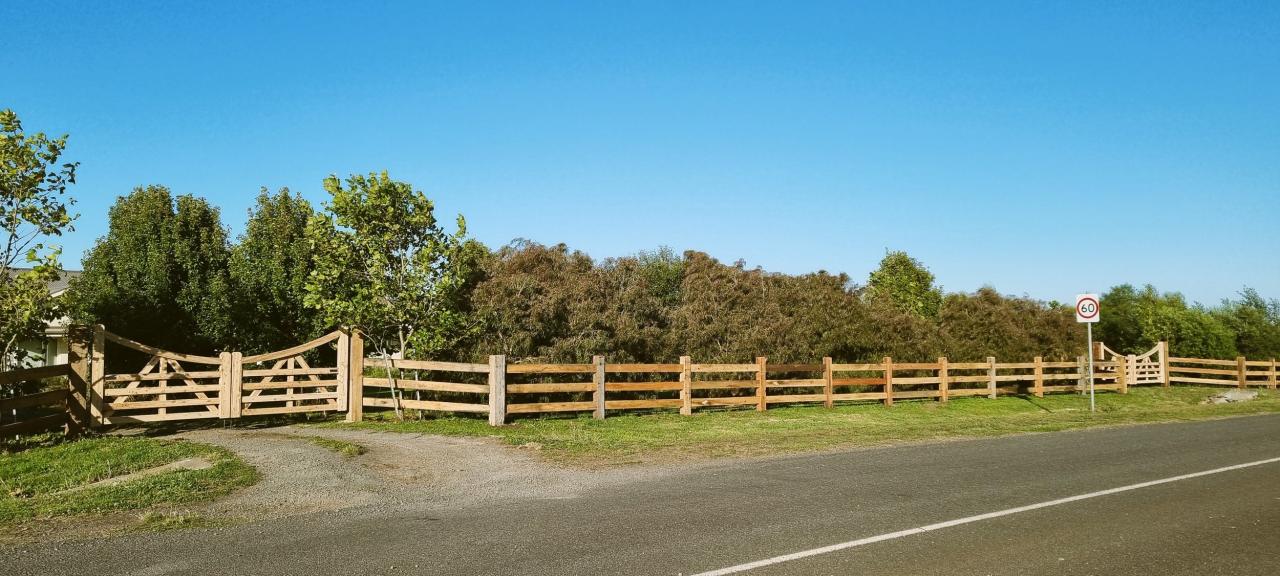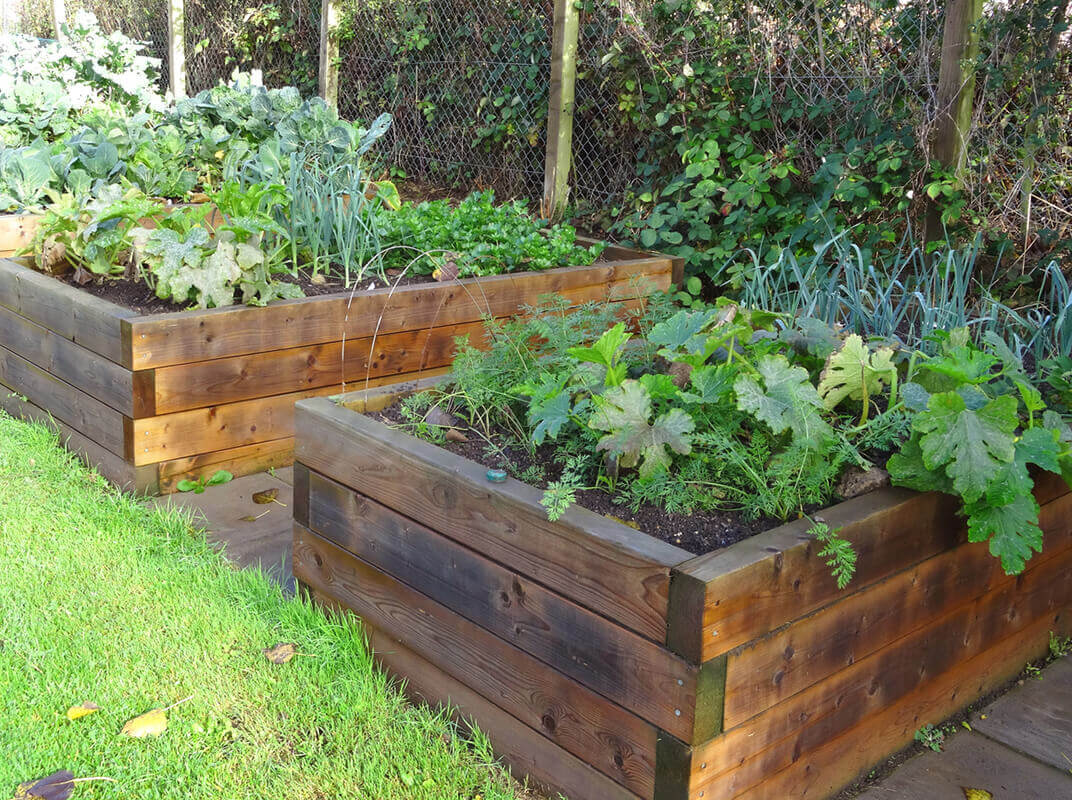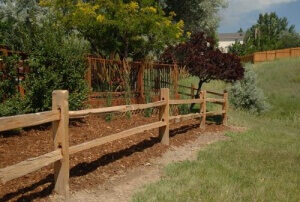One of the benefits of a landscape timber rail fence is that it can be scaled to match the size of the property and the desired level of privacy. A lower fence that only uses two or three rails can provide a decorative boundary, while a taller fence with additional rails can create a more substantial barrier.
Landscape timber rail fences are also popular because of the natural look they provide. The use of rustic timbers and the horizontal rail design create a distinct country feel that is often preferred in rural or wooded areas.
Installation of a landscape timber rail fence is generally straightforward, but proper preparation and leveling of the ground is critical to ensure the fence remains level and sturdy. Maintenance of the fence over time typically involves monitoring the integrity of the timber, ensuring the rails are secure, and cleaning any dirt or debris that accumulates.
When considering a new fence for a property, a landscape timber rail fence may be an option to provide a functional barrier while also enhancing the visual appeal of the area.
Found 45 images related to landscape timber rail fence theme

:max_bytes(150000):strip_icc()/easily-install-a-landscape-timber-edging-2132416_Hero01-aa038b0b265a40ac9e4886137593263b.jpg)




landscape timber rail fence
A fence is not just a barrier that separates your property from your neighbor’s; it is also a defining feature of your home’s exterior design. Whether you want to enclose your garden, corral your livestock, or protect your privacy, a fence made of landscape timber rails can provide both the functionality and the natural charm you seek.
Here we will explore the basics of landscape timber rail fences, including the types of wood, the tools and techniques for installation, the maintenance tips, and some inspiring ideas for your next landscaping project.
Types of Landscape Timber Rail Fence
There are several styles of landscape timber rail fences, each with its distinct aesthetic and functional appeal. Here are the most commonly used ones:
1. Traditional: This is the classic version of landscape timber fence, with evenly spaced, horizontal rails and vertical pickets. It works well for both large and small properties and can be stained or painted to match your home’s color scheme.
2. Ranch-style: Similar to the traditional design, but with fewer and wider rails, this type of fence is ideal for enclosing sprawling ranches or farms. It gives a rustic and sturdy feel to your property and is less likely to warp or sag over time.
3. Split-rail: This fence style, also called “zigzag,” features rough-hewn timber rails that are interlocked without any pickets. It is often used in informal settings or as a decorative accent, such as around a garden or pond. It is easy to install and maintain and has a timeless look that blends well with nature.
Installation of Landscape Timber Rail Fence
Building a landscape timber rail fence requires some planning and effort, but with the right tools and instructions, even a novice DIYer can achieve a professional result. Here are the steps involved:
1. Tools needed:
– Treated landscape timbers (typically 6″ x 8″ x 8′)
– Wooden fence posts (4″ x 4″ or 6″ x 6″, depending on the height of the fence)
– Concrete mix or gravel (for setting the posts)
– Circular saw or hand saw
– Drill and screws
– Level
– Tape measure
– Hammer or sledgehammer
2. Setting posts:
– Determine the layout and dimensions of your fence and mark the locations of the posts.
– Dig holes that are at least one-third the height of the post and twice its width.
– Insert the post and fill the hole with gravel or concrete mix, leaving about 4 inches of clearance from the top.
– Check the post for plumb and level with a spirit level and adjust as needed.
– Let the concrete cure for at least 48 hours before installing the rails.
3. Installing rails and pickets:
– Cut the landscape timbers into 8-foot sections for the rails and 4-foot sections for the pickets.
– Attach the rails to the posts with screws or nails, spacing them evenly and making sure they are level and flush.
– Install the pickets by nailing them to the rails, leaving a gap of 1-2 inches between them.
– Trim the tops of the posts to your preferred height and finish with a cap or finial.
Maintenance and Longevity of Landscape Timber Rail Fence
Often, the beauty of a landscape timber rail fence lies in its natural, untreated appearance, but over time, the wood may weather, crack, and fade if left exposed to the elements. To keep your fence looking its best and prolong its lifespan, you can follow these tips:
1. Staining and sealing: Applying a protective coating of stain or sealer can help repel moisture, UV rays, and insects and prevent the wood from rotting or warping. Choose a product that is safe for outdoor use and matches your desired color and finish.
2. Repairing or replacing damaged sections: If you notice any broken or warped rails or pickets, you can remove and replace them with new ones. You may also need to reinforce the posts or replace them if they show signs of decay or cracking.
3. Lifespan of different types of wood: Not all woods are created equal when it comes to durability and resistance to decay. Cedar, redwood, and cypress are among the most popular choices for landscape timber rail fences, as they have natural oils and resins that make them resistant to rot and insect damage. Pine and fir, on the other hand, are softer and more prone to decay, but they can still last for 5-10 years if treated and maintained properly.
Landscape Timber Rail Fence Ideas
A landscape timber rail fence can add a touch of rustic charm and natural beauty to any property, whether it is a sprawling ranch or a cozy backyard. Here are some ideas to inspire your next landscaping project:
– Use a split-rail fence to encircle a garden or pond and create a rustic accent that blends seamlessly with nature.
– Combine a traditional landscape timber rail fence with wrought iron or stone elements to create a decorative yet functional barrier that complements your home’s design.
– Create a zigzag fence pattern with cedar or redwood rails to give your property a timeless and elegant look that stands out from the crowd.
– Mix and match different sizes and shapes of landscape timbers to create a playful and creative fence design, such as a zigzag, herringbone, or chevron pattern.
– Use landscape timber rail fence as a backdrop for climbing vines, flowers, or shrubs, and create a living fence that changes with the seasons.
FAQs
– Q: What is the difference between landscape timbers and 4×4 posts for fencing?
A: Landscape timbers are typically wider and thicker than 4×4 posts, which makes them more stable and less prone to warping or splitting. They also have a more rustic and natural look that matches well with a country or woodland setting.
– Q: Can I use cinder blocks for a fence instead of landscape timbers?
A: Yes, cinder blocks can be used to build a fence, but they are more suited for retaining walls or structural elements than for decorative fencing. They are also heavier and more challenging to install and may require additional reinforcement for stability.
– Q: What is a jack fence?
A: A jack fence is a style of fence that features overlapping boards or rails that are alternately stacked at different heights. It is often used to create a windbreak or a noise barrier and has a distinctive geometric pattern that adds visual interest to your property.
– Q: How can I build a fence with landscape timbers?
A: To build a fence with landscape timbers, you need to measure and mark the layout of the fence, dig holes for the posts, set the posts in concrete, cut the landscape timbers to size, and attach them to the posts with screws or nails. You can also use metal brackets or T-connectors to make the fence more secure and stable. Consult a professional or a reliable guide for more detailed instructions.
Keywords searched by users: landscape timber rail fence landscape timber fence ideas, landscape timbers, landscape timbers vs 4×4, cinder block fence, split rail fence, jack fence, how to build a fence with landscape timbers
Tag: Collection 80 – landscape timber rail fence
DIY Landscape timber fence
See more here: tuongotchinsu.net
Article link: landscape timber rail fence.
Learn more about the topic landscape timber rail fence.
- How to Make a Fence Out of Landscaping Timbers – Pinterest
- Best Timber for Fencing – Best Wood for Gates – Versace Timbers
- What Timber is Best When Building a Fence?
- How to Install Landscape Timber Edging – The Spruce
- 7 Tips for Making a Fence Out of Landscape Timbers
- 8 Landscaping Timber Fence Ideas: Easy and Affordable
- How to Make a Fence Out of Landscaping Timbers
- Landscaping Timber Fencing | Products
- Timber & Fencing – Landscape – Products – Gardenscapes
- 1927 Timber Fencing Images, Stock Photos & Vectors
Categories: https://tuongotchinsu.net/category/img
